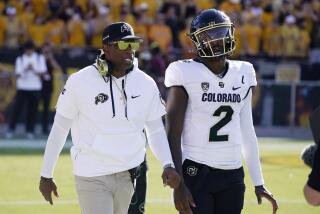Putting the Hurt on Coaches
- Share via
Olivia Kahn had no swimming experience but thought it would be fun to join her San Jose high school’s swim team. The freshman confided to her coach that she was terrified of diving, and she said he promised she could start relays from inside the pool.
During the first two meets, she did not have to dive. But at the third meet, Kahn said, the coach told her: “You either dive in off the blocks or you are not swimming.” The panicky 14-year-old prepared with the help of two fellow swimmers. Minutes before the meet was to start, she took her third practice dive into 3 1/2 feet of water. She broke her neck.
Kahn is now the subject of a case that will determine whether young athletes in California can sue their coaches for sports injuries. The case, which will be decided by the California Supreme Court this summer, will affect not only swim teams but also youth baseball, basketball, wrestling, football -- any sport where injuries are a risk.
Sports organizations fear that a ruling for Kahn would inspire a deluge of lawsuits that would make insurance costs prohibitive for schools, cities that provide recreation facilities, and leagues and sports camps. Although not every broken bone would result in a lawsuit, the costs would be ruinous if even a fraction of those injured sued, they say.
They also argue that few men and women would volunteer to coach if they knew they could be held legally liable for a player’s injuries.
“Paid coaches will probably charge more and get insurance,” said Fred Gregory, national vice president of the American Youth Soccer Organization. “Volunteer coaches are going to disappear.”
A survey in 2000 found that one in three children who participate in organized sports can expect to be injured. Each year, 3.5 million children under age 15 seek medical attention for sports injuries, according to the American Academy of Pediatrics.
Injured athletes and their lawyers say students place their lives in the hands of coaches, and the coaches have a duty to minimize sports’ risks. Allowing injured athletes to sue would help ensure that only the most competent coaches are hired or assigned, they say.
In California, courts have severely restricted lawsuits over sports injuries since a landmark 1991 state Supreme Court case, Knight vs. Jewett.
The case involved a game of touch football played on a Super Bowl Sunday. One of the players, Kendra Knight, said Michael Jewett was playing rough, and she warned him to lighten up. He eventually collided with Knight and stepped on her hand, injuring it and breaking a finger. The finger was later amputated, and she sued Jewett for negligence.
The court said a participant in a sports game is not liable for another’s injury unless the participant “intentionally injures another player or engages in conduct that is so reckless as to be totally outside the range of the ordinary activity involved in the sport.”
A Court of Appeal in San Francisco in 1996 relied on the Knight ruling when it barred a lawsuit over the death of a student in a rock-climbing class. He fell to his death after anchor devices installed by the instructor became loose.
In 1998, a Court of Appeal in Santa Ana upheld the dismissal of a lawsuit brought against the Little League by the family of an 11-year-old boy who was hit in the face by a wild pitch.
The suit claimed that the league should have taken out the pitcher, who already had hit two other boys with pitches. The court said poor pitching is a known risk of baseball.
“Accuracy in pitching, especially from a teenager, has never been a prerequisite to being allowed to pitch,” the court said.
Last month, a Riverside County Superior Court threw out a lawsuit by a former high school football star who hurt his back while weight training with his coach.
The player, now in junior college, said his coach encouraged him to dead-lift 625 pounds. With the coach watching, the boy attempted the lift and ruptured three vertebrae.
He can no longer play football, and doctors have told him he risks paralysis or incontinence if he lifts more than 35 pounds, his lawyer said. His case is being appealed.
Lower courts also had dismissed Kahn’s lawsuit, but it troubled the California Supreme Court enough to review it.
Kahn, now 22, spent months in a hospital after her accident in October 1994 and now walks with a limp. She has little sensation on one side of her body and suffers from headaches, said Patrick McMahon, her lawyer.
An average student in high school, Kahn went to community college for a while and now works from time to time as a receptionist, her lawyer said.
McMahon would not permit Kahn or her parents, a construction worker and a hairstylist, to be interviewed. The lawsuit, filed against the East Side Union High School District and its swim coach, was placed on hold for several years while the extent of her injury was determined.
Kahn testified that the coach, Andrew McKay, did not train her to dive. “The only instruction I ever received on diving before the accident was on one occasion off the deck in the deep pool, from two girls on the swim team,” she said.
She “begged” McKay not to make her dive, she testified. “I told him I was afraid to dive, that I did not know how to do the dive and that I had never dove into the racing pool in my life.”
McKay insisted that he had given Kahn diving instruction. He also said he did not realize she was doing practice dives the day she was hurt. He was surprised when he learned she was diving from the block, which is 18 inches high, because she could have dived from the side of the pool, he said.
Her accident and the lawsuit have made him question coaching.
“It has caused a lot of anguish,” said McKay, 43, who had six years of experience as a head coach at the time of Kahn’s accident.
“It just makes you extra cautious and a little bit paranoid,” he said. “The whole thing was a sad incident, which is bad in itself, but when they start throwing my name around and saying I didn’t train her, it really hurts.”
In upholding a Superior Court’s decision to dismiss Kahn’s lawsuit, a Court of Appeal in Santa Clara County ruled last year that diving is an inherent risk of competitive swimming.
Sport instruction would be hampered if coaches “who merely challenge their students to accomplish more” could be held liable, the court said.
The court called “speculative” Kahn’s argument that training would have prevented her injury. Kahn did not have to swim that day, and she “took it upon herself to practice an unfamiliar dive without her coach’s knowledge, “ the court said in the 2-1 ruling.
A dissenting judge objected that McKay had increased the risk of diving because he had not trained her.
“An inexperienced high school freshman takes up a sport not only to compete, but also to learn,” the dissenter said. “And whereas a part of learning comes from being challenged, an instructor has a duty to avoid unreasonable risk.”
During arguments before the state Supreme Court in June, Chief Justice Ronald M. George observed that a Red Cross manual lists a series of steps for teaching someone how to dive in shallow water. If Kahn didn’t receive that instruction, “doesn’t that meet the standard of recklessness or its equivalent?” George asked.
Justice Marvin Baxter asked what would happen if a high school football coach sent in a 180-pound boy to face a 350-pound tackle and the lighter boy got hurt.
“Is the coach going to be liable for that type of injury?” he asked.
Sharon J. Arkin, who represents trial lawyers in the Kahn case, said the coach would not be liable if he had trained the boy properly.
Baxter persisted. If the court allows athletes to sue their coaches for negligence, there will be a jury trial every time an athlete gets hurt, he said.
“The end result is there won’t be high school athletics,” Baxter said.
Mark Davis, who represents the San Jose school district and Coach McKay, agrees.
If Kahn’s lawsuit is reinstated on grounds that the coach was reckless, athletes who get hurt will simply allege that the coach provided insufficient training, Davis said.
UC Berkeley law professor Steve Barnett, an expert in personal-injury litigation, said that if the court finds Kahn’s coach was reckless, the law on sports injuries will be changed significantly.
“If what happened here is deemed to be reckless, then virtually any other negligence that results in severe injury would be,” Barnett said.
The trial lawyers contend that predictions of a cascade of lawsuits are exaggerated because sports organizations can simply make players and their parents sign waivers that spell out the possible dangers and release the groups and coaches from liability.
But attorneys for sports organizations and school districts say that although signed waivers are a line of defense, they do not stop all lawsuits. Waivers must be carefully written, and they can be thrown out by a court if they are perceived to violate sound public policy.
The California Ski Industry Assn. was concerned enough about the Kahn case to present written and oral arguments on behalf of the school district.
Joseph P. Collins, a lawyer for the industry, said the court’s 1991 landmark ruling established a policy in California to encourage recreational activities. The decision has largely protected the state’s ski resorts from lawsuits by injured skiers for a decade, he said.
McMahon scoffs at the predictions that sports programs will be at peril if the court rules for Kahn.
“If she had got any training, there wouldn’t be a case,” he said. “If a coach does the job he is hired to do, it will have no effect,” he said.
McMahon predicts that the school district will settle the Kahn case if the court rules for his client. She could be compensated for medical bills, pain and suffering and lost wages.
“You can bet your bottom dollar on it,” said McMahon, who refused to estimate how much his client might win. Given the facts of the case, “what do you think a jury would do with it? They’d go nuts.”
More to Read
Get our high school sports newsletter
Prep Rally is devoted to the SoCal high school sports experience, bringing you scores, stories and a behind-the-scenes look at what makes prep sports so popular.
You may occasionally receive promotional content from the Los Angeles Times.







